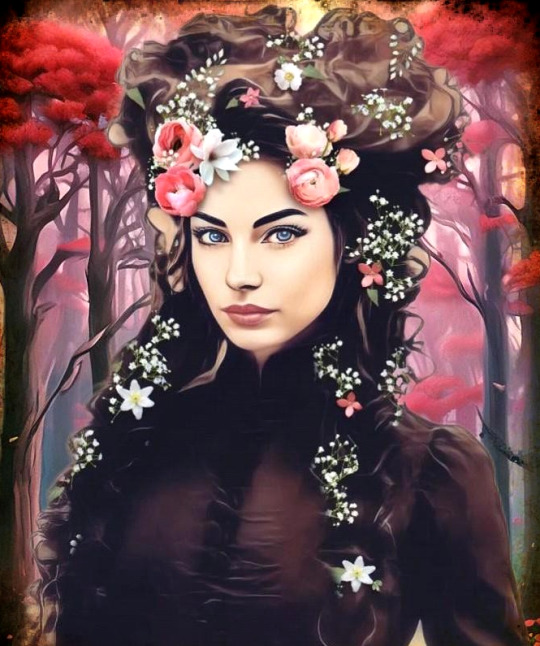#Camille Monfort
Explore tagged Tumblr posts
Text

Camille Marie Monfort is a fictional character created by Brazilian author Bosco Chansen in his book “Após a Chuva da Tarde” (“After the Afternoon Rain”). According to the narrative, she was a French opera singer born in 1869 who moved to Belém, Brazil, during the late 19th century. Her beauty and unconventional behavior led to rumors of vampirism, earning her the nickname “The Amazonian Vampire.” The story culminates with her alleged death during a cholera outbreak in 1896 and her burial in the Soledade Cemetery in Belém. However, it’s important to note that this tale is a work of fiction, and there are no historical records supporting the existence of Camille Monfort.
4 notes
·
View notes
Text

Camille Monfort "The Amazonian Vampire" by Ruth Elizabeth Stiff via vocal.media
(1869 - 1896)
She was young, beautiful and enchanted audiences with her voice. She was called “The Amazonian Vampire” because of her pale features and late-night walks. Rich gentlemen desired her and their wives were atrociously jealous of her beauty.
She was Camille Monfort.
Camille was born in 1869, in France, and her father was Henri Monfort and her mother was Marie Monfort. Her father, Henri, was a French diplomat and the consulate-general of France in Belem, the capital state of Para in Brazil. Her mother, Marie, was a French Aristocrat who was related to the Royal family of Orleans. It’s safe to say that Camille enjoyed a privileged upbringing.
In 1876, the family moved to Brazil. Camille’s two older brothers, Louis and Charles, followed their father into a diplomatic career. The family were Roman Catholic. Not much is recorded about her education, but with this kind of lifestyle, Camille was sure to have a governess, learning about the Brazilian culture and its history.
Camille never married, which is a surprise as she was very beautiful, standing at 5 feet 5 inches tall and having a ‘decent’ waist. Many admired her free spirit and her ‘independent’ aura. However, despite all of this, Camille lived a short life, interesting but short. Camille lived by her own rules.
She had a ‘notorious’ love life, having affairs with married men, including barons, politicians, journalists and diplomats. No doubt, with her father being the consulate-general of France, Camille’s world was opened up to meet many people, men and women.
Camille preferred her life in the theatre, being an outstanding opera singer, attracting large audiences with her performances. This profession gave her freedom to have her own luxurious lifestyle, although her financial net worth is not recorded.
As very little is actually “known” about Camille, her life has been ‘open’ to much speculation and mystery. She has become a subject of fascination and curiosity. The ‘tales’ that have emerged over the years make us believe that Camille was a unique and interesting person.
It was ‘believed’ (for example) that this powerful opera singer had the habit of indulging in champagne baths. People believed that Camille would dance through the streets under the afternoon rain. These stories got out of hand, however, because people started to ‘believe’ that this young woman was a vampire, and that Camille would hypnotize her unsuspecting victims with her mesmerizing voice. Her pale complexion only encouraged these wild rumours, which were possibly spread by the jealous wives of the husbands she was said to have had affairs with.
It is true that people would faint during her performances but instead of her hypnotizing the person, it was probably because of the strong emotions that her singing would evoke in the audience.
‘People’ believed that Camille could communicate with the dead, and materialize their spirits in dense ethereal mists of ectoplasmic matter, which the young woman would expel from her body during a mediumistic session. Undoubtedly, this was the start of the Spiritualist movement in Brazil, which was practiced in the palaces of Belem by mysterious cults.
Whatever the truth is, there was an outbreak of cholera by the end of 1896, which swept through the city of Belem, and it took Camille’s young life. Camille was only 25 years of age when she died and she was laid in the Cemetery of Solitude in Batz-sur-Mer, France.
During her young life, Camille was not only a very talented opera singer who studied classical music at the Conservatoire de Paris, but she could also speak Italian, German, English and Portuguese. She learnt to play the piano, violin and the guitar. When she was performing, Camille travelled Europe and performed in several theatres and salons. Her talent and beauty became legendary for the time in which she lived. She had an independent and rebellious spirit, dressing in the most fashionable clothes of the time, some of the dresses were thought to be quite provocative. Camille would smoke, ride horses and drive the newly invented motor car. Her lovers showered her with gifts but Camille never settled down with any one of them.
Camille Monfort’s ‘legend’ has inspired many works of art and literature, novels, poems, as well as songs, paintings and even the odd film or two. Even today, Camille is remembered and revered by people who visit her grave to mark their ‘respect’ for “The Amazonian Vampire”.

Camille Monfort, The 1896 Legendary Tale of "The Amazonian Vampire”. By Victor Amah via vocal.media
In 1896, Belém became rich by selling Amazonian rubber to the world, making the farmers overnight millionaires who built their rich mansions with European materials, while their wives and daughters sent their clothes to be washed in the old continent and imported mineral water from London for their baths.
The "Theatro da Paz" was the center of cultural life in the Amazon, with concerts by European artists. Among them, one especially caught the public's attention, the beautiful French opera singer Camille Monfort (1869-1896), who provoked indescribable desires in the rich gentlemen of the region and atrocious jealousy in their wives due to her great beauty.
Camille Monfort also caused indignation for her behavior, which was free from the social conventions of her time. Legend has it that she was seen half-naked, dancing in the streets of Belém while refreshing herself in the afternoon rain. Her solitary night walks also aroused curiosity when she was seen in her long, black, and vaporous dresses under the full moon, on the banks of the Guajará River, towards the Igarapé das Almas.
Soon, rumors began to circulate around her, and malicious comments were made. It was said that she was the lover of Francisco Bolonha (1872-1938), who had brought her from Europe and that he bathed her with expensive imported champagnes in the bathtub of his mansion.
It was also said that she had been attacked by vampirism in London, due to her paleness and sickly appearance, and that she had brought this great evil to the Amazon, having a mysterious craving for human blood, to the point of hypnotizing young women with her voice in her concerts, making them fall asleep in her dressing room so that the mysterious lady could reach their necks. Curiously, this coincided with reports of fainting in the theater during her concerts, which were simply explained as the effect of the strong emotion that her music produced in the audience's ears.
It was also said that she had the power to communicate with the dead and materialize their spirits into dense ethereal mists of ectoplasmic materials expelled from her own body in mediumistic sessions. These were undoubtedly the first manifestations in the Amazon of what would later be called spiritualism, practiced in mysterious cults in Belém palaces, such as the Palacete Pinho.
At the end of 1896, a terrible cholera outbreak devastated the city of Belém, turning Camille Monfort into one of its victims, who was buried in the Cemetery of Solitude.
Today, her tomb is still there, covered in slime, moss, and dry leaves, under a huge mango tree that makes her grave sink into the darkness of its shadow, only illuminated by rays of sun that penetrate through the green leaves.
It is a neoclassical mausoleum with a door closed by an old rusty lock, from which a white marble female bust can be seen on the wide lid of the abandoned tomb, and attached to the wall, a small framed image of a woman dressed in black.
#classical music#opera#music history#bel canto#composer#classical composer#aria#classical studies#maestro#chest voice#Camille Monfort#The Amazonian Vampire#classical musician#classical musicians#classical history#opera history#history of music#history#historian of music#musician#musicians#diva#prima donna
4 notes
·
View notes
Text

Camille Monfort
la légende du 'Vampire de l'Amazonie' (1896)
35 notes
·
View notes
Text

Camille Monfort, LA LEYENDA de "La vampira amazona" (1896).
En 1896, Belém se enriqueció vendiendo caucho amazónico al mundo, enriqueciendo de la noche a la mañana a los campesinos, quienes construían sus ricas mansiones con materiales de Europa, mientras sus esposas e hijas enviaban su ropa al viejo continente para ser lavada, e importaban agua mineral de Londres. para sus baños.
El "Theatro da Paz" fue el centro de la vida cultural en la Amazonía, con conciertos de artistas europeos. Entre ellos, llamó especialmente la atención del público uno, la bella cantante de ópera francesa Camille Monfort (1869 – 1896), quien provocaba indecibles deseos en los ricos señores de la región, y atroces celos en sus esposas por su gran belleza.
Camille Monfort también causó indignación por su comportamiento libre de las convenciones sociales de su época. Cuenta la leyenda que se la vio semidesnuda, bailando por las calles de Belém, mientras se refrescaba en la lluvia de la tarde, y también despertaron la curiosidad sus solitarios paseos nocturnos, cuando la vieron con sus largos vestidos negros y vaporosos, bajo la luna llena, a orillas del río Guajará, hacia el Igarapé das Almas.
Pronto, a su alrededor, se crearon rumores y se dieron vida a comentarios maliciosos. Se decía que era la amante de Francisco Bolonha (1872 – 1938), que la había traído de Europa, y que él la bañaba con caros champagnes importados de Europa, en la bañera de su mansión.
También se decía que había sido atacada por el vampirismo en Londres, debido a su palidez y aspecto enfermizo, y que había traído este gran mal a la Amazonía, teniendo unas misteriosas ansias de beber sangre humana, al punto de hipnotizar a las jóvenes. con su voz en sus conciertos, haciendo que se durmieran en su camerino, para que la misteriosa dama pudiera llegar a sus cuellos. Lo cual, curiosamente, coincidió con relatos de desmayos en el teatro durante sus conciertos, que se explicaban simplemente como efecto de la fuerte emoción que su música producía en los oídos del público.
También se decía que tenía el poder de comunicarse con los muertos, y de materializar sus espíritus en densas nieblas etéreas de materiales ectoplasmáticos expulsados de su propio cuerpo, en sesiones mediúmnicas. Sin duda, fueron las primeras manifestaciones en la Amazonía de lo que luego se llamaría espiritismo, practicado en cultos misteriosos en palacios de Belém, como el Palacete Pinho.
A fines de 1896, un terrible brote de cólera asoló la ciudad de Belém, convirtiendo a Camille Monfort en una de sus víctimas, quien fue enterrada en el Cementerio de la Soledad.
Hoy, su tumba sigue allí, cubierta de limo, musgo y hojas secas, bajo un enorme árbol de mango que hace que su tumba se sumerja en la oscuridad de su sombra, solo iluminada por unos rayos de sol que se proyectan a través de las hojas verdes.
Se trata de un mausoleo neoclásico con una puerta cerrada por un viejo candado oxidado, de la que se puede ver un busto femenino en mármol blanco sobre la amplia tapa de la tumba abandonada, y adosada a la pared, una pequeña imagen enmarcada de una mujer vestida con negro.
En su lápida se puede leer la inscripción:
"Aqui yace
Camila María Monfort (1869-1896)
La voz que cautivó al mundo".
Pero hay quienes todavía hoy dicen que su tumba está vacía, que su muerte y entierro no fueron más que un acto para encubrir su caso de vampirismo, y que Camille Monfort aún vive en Europa, hoy a la edad de 154 años.
(La imagen original ha sido retocada para extraponer los detalles. Y no, no es un móvil lo que lleva en las manos, es una pequeña libreta).
6 notes
·
View notes
Text
Camille Monfort, LA LEYENDA de "La vampira amazona" (1896)
En 1896, Belém se enriqueció vendiendo caucho amazónico al mundo, enriqueciendo de la noche a la mañana a los campesinos, quienes construían sus ricas mansiones con materiales de Europa, mientras sus esposas e hijas enviaban su ropa al viejo continente para ser lavada, e importaban agua mineral de Londres. para sus baños.El “Theatro da Paz” fue el centro de la vida cultural en la Amazonía, con…
0 notes
Text

Camille Marie Monfort (1863-1893) lived in Belem, Brazilian and was a French lyrical singer
2 notes
·
View notes
Text
Camille Monfort

The Amazon Vampire - a French opera singer who captivated the elite of Belém, Brazil in the late 19th century. Monfort is said to have died from cholera in 1896, but some legends claim she was actually a vampire who used the epidemic to cover her supernatural activities.

There are still those who say today that her tomb is empty, that her death and burial were nothing more than an act to cover up her case of vampirism, and that Camille Monfort still lives in Europe, now at the age of 154.
97 notes
·
View notes
Text

Camille Monfort, LA LEYENDA de "La vampira amazona" (1896).
En 1896, Belém se enriqueció vendiendo caucho amazónico al mundo, enriqueciendo de la noche a la mañana a los campesinos, quienes construían sus ricas mansiones con materiales de Europa, mientras sus esposas e hijas enviaban su ropa al viejo continente para ser lavada, e importaban agua mineral de Londres. para sus baños.
El "Theatro da Paz" fue el centro de la vida cultural en la Amazonía, con conciertos de artistas europeos. Entre ellos, llamó especialmente la atención del público uno, la bella cantante de ópera francesa Camille Monfort (1869 – 1896), quien provocaba indecibles deseos en los ricos señores de la región, y atroces celos en sus esposas por su gran belleza.
Camille Monfort también causó indignación por su comportamiento libre de las convenciones sociales de su época. Cuenta la leyenda que se la vio semidesnuda, bailando por las calles de Belém, mientras se refrescaba en la lluvia de la tarde, y también despertaron la curiosidad sus solitarios paseos nocturnos, cuando la vieron con sus largos vestidos negros y vaporosos, bajo la luna llena, a orillas del río Guajará, hacia el Igarapé das Almas.
Pronto, a su alrededor, se crearon rumores y se dieron vida a comentarios maliciosos. Se decía que era la amante de Francisco Bolonha (1872 – 1938), que la había traído de Europa, y que él la bañaba con caros champagnes importados de Europa, en la bañera de su mansión.
También se decía que había sido atacada por el vampirismo en Londres, debido a su palidez y aspecto enfermizo, y que había traído este gran mal a la Amazonía, teniendo unas misteriosas ansias de beber sangre humana, al punto de hipnotizar a las jóvenes. con su voz en sus conciertos, haciendo que se durmieran en su camerino, para que la misteriosa dama pudiera llegar a sus cuellos. Lo cual, curiosamente, coincidió con relatos de desmayos en el teatro durante sus conciertos, que se explicaban simplemente como efecto de la fuerte emoción que su música producía en los oídos del público.
También se decía que tenía el poder de comunicarse con los muertos, y de materializar sus espíritus en densas nieblas etéreas de materiales ectoplasmáticos expulsados de su propio cuerpo, en sesiones mediúmnicas. Sin duda, fueron las primeras manifestaciones en la Amazonía de lo que luego se llamaría espiritismo, practicado en cultos misteriosos en palacios de Belém, como el Palacete Pinho.
A fines de 1896, un terrible brote de cólera asoló la ciudad de Belém, convirtiendo a Camille Monfort en una de sus víctimas, quien fue enterrada en el Cementerio de la Soledad.
Hoy, su tumba sigue allí, cubierta de limo, musgo y hojas secas, bajo un enorme árbol de mango que hace que su tumba se sumerja en la oscuridad de su sombra, solo iluminada por unos rayos de sol que se proyectan a través de las hojas verdes.
Se trata de un mausoleo neoclásico con una puerta cerrada por un viejo candado oxidado, de la que se puede ver un busto femenino en mármol blanco sobre la amplia tapa de la tumba abandonada, y adosada a la pared, una pequeña imagen enmarcada de una mujer vestida con negro.
En su lápida se puede leer la inscripción:
"Aqui yace
Camila María Monfort (1869-1896)
La voz que cautivó al mundo".
Pero hay quienes todavía hoy dicen que su tumba está vacía, que su muerte y entierro no fueron más que un acto para encubrir su caso de vampirismo, y que Camille Monfort aún vive en Europa, hoy a la edad de 154 años.
(La imagen original ha sido retocada para extraponer los detalles. Y no, no es un móvil lo que lleva en las manos, es una pequeña libreta).
14 notes
·
View notes
Text
Camille Monfort, LA LEYENDA de "La vampira amazona" (1896). En 1896, Belém se enriqueció vendiendo caucho amazónico al mundo, enriqueciendo de la noche a la mañana a los campesinos, quienes construían sus ricas mansiones con materiales de Europa, mientras sus esposas e hijas enviaban su ropa al viejo continente para ser lavada, e importaban agua mineral de Londres. para sus baños. El "Theatro da Paz" fue el centro de la vida cultural en la Amazonía, con conciertos de artistas europeos. Entre ellos, llamó especialmente la atención del público uno, la bella cantante de ópera francesa Camille Monfort (1869 – 1896), quien provocaba indecibles deseos en los ricos señores de la región, y atroces celos en sus esposas por su gran belleza. Camille Monfort también causó indignación por su comportamiento libre de las convenciones sociales de su época. Cuenta la leyenda que se la vio semidesnuda, bailando por las calles de Belém, mientras se refrescaba en la lluvia de la tarde, y también despertaron la curiosidad sus solitarios paseos nocturnos, cuando la vieron con sus largos vestidos negros y vaporosos, bajo la luna llena, a orillas del río Guajará, hacia el Igarapé das Almas. Pronto, a su alrededor, se crearon rumores y se dieron vida a comentarios maliciosos. Se decía que era la amante de Francisco Bolonha (1872 – 1938), que la había traído de Europa, y que él la bañaba con caros champagnes importados de Europa, en la bañera de su mansión. También se decía que había sido atacada por el vampirismo en Londres, debido a su palidez y aspecto enfermizo, y que había traído este gran mal a la Amazonía, teniendo unas misteriosas ansias de beber sangre humana, al punto de hipnotizar a las jóvenes. con su voz en sus conciertos, haciendo que se durmieran en su camerino, para que la misteriosa dama pudiera llegar a sus cuellos. Lo cual, curiosamente, coincidió con relatos de desmayos en el teatro durante sus conciertos, que se explicaban simplemente como efecto de la fuerte emoción que su música producía en los oídos del público. También se decía que tenía el poder de comunicarse con los muertos, y de materializar sus espíritus en densas nieblas etéreas de materiales ectoplasmáticos expulsados de su propio cuerpo, en sesiones medium . Sin duda, fueron las primeras manifestaciones en la Amazonía de lo que luego se llamaría espiritismo, practicado en cultos misteriosos en palacios de Belém, como el Palacete Pinho. A fines de 1896, un terrible brote de cólera asoló la ciudad de Belém, convirtiendo a Camille Monfort en una de sus víctimas, quien fue enterrada en el Cementerio de la Soledad. Hoy, su tumba sigue allí, cubierta de limo, musgo y hojas secas, bajo un enorme árbol de mango que hace que su tumba se sumerja en la oscuridad de su sombra, solo iluminada por unos rayos de sol que se proyectan a través de las hojas verdes. Se trata de un mausoleo neoclásico con una puerta cerrada por un viejo candado oxidado, de la que se puede ver un busto femenino en mármol blanco sobre la amplia tapa de la tumba abandonada, y adosada a la pared, una pequeña imagen enmarcada de una mujer vestida con negro. En su lápida se puede leer la inscripción: "Aqui yace Camila María Monfort (1869-1896) La voz que cautivó al mundo". Pero hay quienes todavía hoy dicen que su tumba está vacía, que su muerte y entierro no fueron más que un acto para encubrir su caso de vampirismo, y que Camille Monfort aún vive en Europa, hoy a la edad de 154 años.
(La imagen original ha sido retocada para extraponer los detalles. Y no, no es un móvil lo que lleva en las manos, es una pequeña libreta).
Tomado de El Rincón de la Brujería Antigua

8 notes
·
View notes
Text











A moodboard for Trigun fic Love & Violence!
Fic Summary: A town of humans accidentally rehabilitate a floundering, injured Knives after his deadly battle with Vash. Canon divergent gen fic.
Photo Inspirations:
Millions Knives - Oliver Stummvoll
Cain Remak (OC) - Stephen Lang
Evie Remak (OC) - Camille Monfort
Rosa - Maude Adams
Zazie the Beast - REZZ x Blanke - Everywhere, Nowhere Music Video
#Trigun#Tristamp#Millions Knives#Love & Violence#Zazie the Beast#Rosa (Trigun: Stampede)#Cain Remak (OC)#Evie Remak (OC)#yoooo I've had this moodboard sitting around for weeks lol#finally got around to posting it!#there's just something about Oliver Stummvoll that makes me think of a moody vulnerable Knives guh#And then I got to thinking about other characters too#idk was just kinda fun to play around#I've got about 9 pages of the next chapter so far!#thanks to anyone still reading or supporting this wild story#it's grown a lot from the one-shot it was supposed to be lol
10 notes
·
View notes
Text

Camille Monfort, The 1896 Legendary Tale of "The Amazonian Vampire”.
Camille Monfort, The 1896 Legendary Tale of "The Amazonian Vampire”.
In 1896, Belém became rich by selling Amazonian rubber to the world, making the farmers overnight millionaires who built their rich mansions with European materials, while their wives and daughters sent their clothes to be washed in the old continent and imported mineral water from London for their baths.
The "Theatro da Paz" was the center of cultural life in the Amazon, with concerts by European artists. Among them, one especially caught the public's attention, the beautiful French opera singer Camille Monfort (1869-1896), who provoked indescribable desires in the rich gentlemen of the region and atrocious jealousy in their wives due to her great beauty.
Camille Monfort also caused indignation for her behavior, which was free from the social conventions of her time. Legend has it that she was seen half-naked, dancing in the streets of Belém while refreshing herself in the afternoon rain. Her solitary night walks also aroused curiosity when she was seen in her long, black, and vaporous dresses under the full moon, on the banks of the Guajará River, towards the Igarapé das Almas.
Soon, rumors began to circulate around her, and malicious comments were made. It was said that she was the lover of Francisco Bolonha (1872-1938), who had brought her from Europe and that he bathed her with expensive imported champagnes in the bathtub of his mansion.
It was also said that she had been attacked by vampirism in London, due to her paleness and sickly appearance, and that she had brought this great evil to the Amazon, having a mysterious craving for human blood, to the point of hypnotizing young women with her voice in her concerts, making them fall asleep in her dressing room so that the mysterious lady could reach their necks. Curiously, this coincided with reports of fainting in the theater during her concerts, which were simply explained as the effect of the strong emotion that her music produced in the audience's ears.
It was also said that she had the power to communicate with the dead and materialize their spirits into dense ethereal mists of ectoplasmic materials expelled from her own body in mediumistic sessions. These were undoubtedly the first manifestations in the Amazon of what would later be called spiritualism, practiced in mysterious cults in Belém palaces, such as the Palacete Pinho.
At the end of 1896, a terrible cholera outbreak devastated the city of Belém, turning Camille Monfort into one of its victims, who was buried in the Cemetery of Solitude.
Today, her tomb is still there, covered in slime, moss, and dry leaves, under a huge mango tree that makes her grave sink into the darkness of its shadow, only illuminated by rays of sun that penetrate through the green leaves.
It is a neoclassical mausoleum with a door closed by an old rusty lock, from which a white marble female bust can be seen on the wide lid of the abandoned tomb, and attached to the wall, a small framed image of a woman dressed in black.
On her tombstone, you can read the inscription:
"Here lies Camila María Monfort (1869-1896) The voice that captivated the world."
But there are still those who say today that her tomb is empty, that her death and burial were nothing more than an act to cover up her case of vampirism, and that Camille Monfort still lives in Europe, now at the age of 154.
10 notes
·
View notes
Text

In 1896, Belém became rich by selling Amazonian rubber to the world, making the farmers overnight millionaires who built their rich mansions with European materials, while their wives and daughters sent their clothes to be washed in the old continent and imported mineral water from London for their baths.
The "Theatro da Paz" was the center of cultural life in the Amazon, with concerts by European artists. Among them, one especially caught the public's attention, the beautiful French opera singer Camille Monfort (1869-1896), who provoked indescribable desires in the rich gentlemen of the region and atrocious jealousy in their wives due to her great beauty.
Camille Monfort also caused indignation for her behavior, which was free from the social conventions of her time. Legend has it that she was seen half-naked, dancing in the streets of Belém while refreshing herself in the afternoon rain. Her solitary night walks also aroused curiosity when she was seen in her long, black, and vaporous dresses under the full moon, on the banks of the Guajará River, towards the Igarapé das Almas.
Soon, rumors began to circulate around her, and malicious comments were made. It was said that she was the lover of Francisco Bolonha (1872-1938), who had brought her from Europe and that he bathed her with expensive imported champagnes in the bathtub of his mansion.
It was also said that she had been attacked by vampirism in London, due to her paleness and sickly appearance, and that she had brought this great evil to the Amazon, having a mysterious craving for human blood, to the point of hypnotizing young women with her voice in her concerts, making them fall asleep in her dressing room so that the mysterious lady could reach their necks.
Curiously, this coincided with reports of fainting in the theater during her concerts, which were simply explained as the effect of the strong emotion that her music produced in the audience's ears.
It was also said that she had the power to communicate with the dead and materialize their spirits into dense ethereal mists of ectoplasmic materials expelled from her own body in mediumistic sessions. These were undoubtedly the first manifestations in the Amazon of what would later be called spiritualism, practiced in mysterious cults in Belém palaces, such as the Palacete Pinho.
At the end of 1896, a terrible cholera outbreak devastated the city of Belém, turning Camille Monfort into one of its victims, who was buried in the Cemetery of Solitude.
Today, her tomb is still there, covered in slime, moss, and dry leaves, under a huge mango tree that makes her grave sink into the darkness of its shadow, only illuminated by rays of sun that penetrate through the green leaves.
It is a neoclassical mausoleum with a door closed by an old rusty lock, from which a white marble female bust can be seen on the wide lid of the abandoned tomb, and attached to the wall, a small framed image of a woman dressed in black.
On her tombstone, you can read the inscription:
"Here lies Camila María Monfort (1869-1896) The voice that captivated the world."
She embedded fear and share power to her subordinates by selling rubber to the people of Europe and the world at large but when are in her home she always gave you a new kind of fear
But there are still those who say today that her tomb is empty, that her death and burial were nothing more than an act to cover up her case of vampirism, and that Camille Monfort still lives in Europe, now at the age of 154.
8 notes
·
View notes
Text
In 1896, Belém became rich selling Amazonian rubber to the world, enriching the peasants overnight, who built their rich mansions with materials from Europe, while their wives and daughters sent their clothes to the old continent to be washed with London mineral water. The "Theatro da Paz" was the center of cultural life in the Amazon, with concerts by European artists. Among them, one especially caught the attention of the public, the beautiful French opera singer Camille Monfort (1869 – 1896), who provoked unspeakable desires in the rich lords of the region, and atrocious jealousy in their wives due to her great beauty. Camille Monfort also provoked outrage for her behavior free from the social conventions of her time. Legend has it that she was seen half-naked, dancing through the streets of Belém, while cooling off in the afternoon rain, and her solitary night walks also aroused curiosity, when they saw her in her long, flowing black dresses, under the full moon, on the banks of the Guajará River, towards the Igarapé das Almas.
Soon, rumors were created around her and malicious comments were given life. It was said that she was the lover of Francisco Bolonha (1872 – 1938), who had brought her from Europe, and that he bathed her with expensive champagnes imported from Europe, in the bathtub of his mansion. It was also said that she had been attacked by vampirism in London, due to her paleness and sickly appearance, and that she had brought this great evil to the Amazon, having a mysterious desire to drink human blood to the point of hypnotizing young girls with her voice at her concerts and making them fall asleep in her dressing room, so the mysterious lady could get to their necks. Curiously, coincided with reports of fainting in the theater during her concerts, which were explained simply as an effect of the strong emotion that her music produced in the audience's ears. It was also said that she had the power to communicate with the dead, and to materialize their spirits in dense ethereal mists of ectoplasmic materials expelled from her own body, in mediumistic sessions. Without a doubt, they were the first manifestations in the Amazon of what would later be called spiritualism, practiced in mysterious cults in palaces in Belém, such as the Pinho Palace.
At the end of 1896, a terrible outbreak of cholera devastated the city of Belém, making Camille Monfort one of its victims, who was buried in the Soledad Cemetery. Today, her grave is still there, covered in silt, moss and dry leaves, under a huge mango tree that makes her grave submerge in the darkness of its shadow, only illuminated by a few rays of sun that are projected through the green leaves. It's a neoclassical mausoleum with a door closed by an old rusty padlock, from which you can see a female bust in white marble on the wide lid of the abandoned tomb, and attached to the wall, a small framed image of a woman dressed in black. On her tombstone you can read the inscription: "Here lies Camila María Monfort (1869-1896) The voice that captivated the world." But there are those who still today say that her tomb is empty, that her death and burial were nothing more than an act to cover up her case of vampirism, and that Camille Monfort still lives in Europe, today at the age of 154.
(The original image has been retouched to add details. And no, It's not a phone that she's carrying in her hands, it is a small notebook.)


2 notes
·
View notes
Text

Camille Monfort, la légende du "Vampire de l'Amazonie" (1896).
En 1896, Belém s'enrichit en vendant le caoutchouc amazonien au monde entier, enrichissant du jour au lendemain les paysans qui construisent leurs riches demeures avec des matériaux venus d'Europe, tandis que leurs femmes et leurs filles envoient leurs vêtements se faire laver sur le vieux continent et importent de l'eau minérale de Londres pour leurs bains.
Le "Theatro da Paz" était le centre de la vie culturelle en Amazonie, avec des concerts d'artistes européens. Parmi eux, l'un d'entre eux attirait particulièrement l'attention du public, la belle chanteuse d'opéra française Camille Monfort (1869 - 1896), qui suscitait des désirs inavouables chez les riches seigneurs de la région, et une jalousie atroce chez ses épouses en raison de sa grande beauté.
Camille Monfort a également suscité l'indignation pour son comportement affranchi des conventions sociales de son époque. La légende raconte qu'on l'a vue, à moitié nue, danser dans les rues de Belém, alors qu'elle se rafraîchissait sous la pluie de l'après-midi, et la curiosité a également été attisée par ses promenades nocturnes solitaires, lorsqu'on l'a vue dans ses longues robes noires et fluides, sous la pleine lune, sur les rives du fleuve Guajará, vers l'Igarapé das Almas.
Bientôt, autour d'elle, des rumeurs se créent et des commentaires malveillants prennent vie. On disait qu'elle était l'amante de Francisco Bolonha (1872 - 1938), qui l'avait ramenée d'Europe, et qu'il la baignait avec de coûteux champagnes importés d'Europe, dans la baignoire de son manoir.
On disait aussi qu'elle avait été attaquée par le vampirisme à Londres, à cause de sa pâleur et de son apparence maladive, et qu'elle avait apporté ce grand mal à l'Amazonie, ayant une mystérieuse envie de boire du sang humain, au point d'hypnotiser les jeunes femmes avec sa voix lors de ses concerts, les faisant s'endormir dans sa loge, pour que la mystérieuse dame puisse leur atteindre le cou. Ce qui, curieusement, coïncidait avec des rapports d'évanouissements dans le théâtre pendant ses concerts, expliqués simplement comme un effet de la forte émotion que sa musique produisait dans les oreilles du public.
On disait aussi qu'elle avait le pouvoir de communiquer avec les morts et de matérialiser ses esprits dans des brumes éthérées denses de matériaux ectoplasmiques expulsés de son propre corps, lors de séances de médiumnité. Il s'agit sans aucun doute des premières manifestations en Amazonie de ce que l'on appellera plus tard le spiritisme, pratiqué dans des cultes mystérieux dans des palais de Belém, comme le Palacete Pinho.
À la fin de l'année 1896, une terrible épidémie de choléra ravagea la ville de Belém, faisant de Camille Monfort l'une de ses victimes, qui fut enterrée dans le cimetière de Soledade.
Aujourd'hui, sa tombe est toujours là, couverte de boue, de mousse et de feuilles sèches, sous un énorme manguier qui la fait plonger dans l'obscurité de son ombre, seulement éclairée par quelques rayons de soleil projetés à travers les feuilles vertes.
Il s'agit d'un mausolée néoclassique dont la porte est fermée par un vieux cadenas rouillé, d'où l'on peut voir un buste de femme en marbre blanc sur le large couvercle de la tombe abandonnée, et attachée au mur, une petite image encadrée d'une femme vêtue de noir.
Sur sa pierre tombale, on peut lire l'inscription :
« Ci-gît
Camille Marie Monfort (1869 - 1896)
La voix qui a charmé le monde ».
Mais certains affirment encore aujourd'hui que sa tombe est vide, que sa mort et son enterrement n'étaient rien d'autre qu'un acte visant à dissimuler son cas de vampirisme, et que Camille Monfort vit toujours en Europe, aujourd'hui à l'âge de 154 ans.
(L'image originale a été retouchée pour extraire les détails. Et non, ce n'est pas un téléphone portable qu'elle tient dans ses mains, mais un petit carnet).
24 notes
·
View notes



